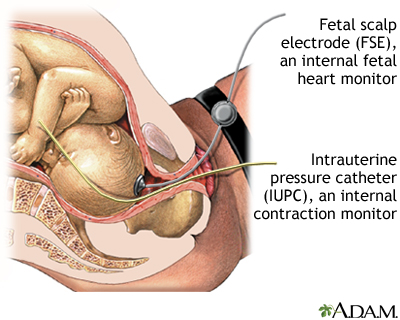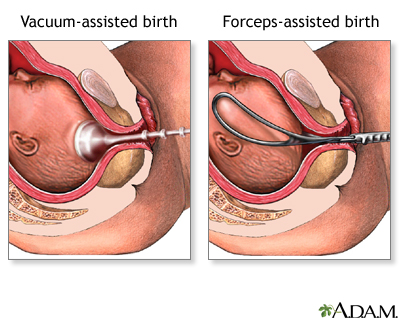Procedures That May Take Place During Labor And Delivery
Once you arrive at the hospital in labor, there are various procedures that may be done. Your health and the baby's health will be monitored while you are in labor. In some cases, it is necessary for the doctor to assist with the delivery using forceps or vacuum extraction.
Fetal Monitoring During Labor
In order to check the well-being of the baby while you are in labor, your health care providers will monitor the baby's heart rate. While fetal heart monitoring does not prevent a problem from occurring, but changes in the baby's heart rate can help to alert the health care provider that something might be wrong.
- Auscultation: In this technique, the nurse or doctor listens to the baby's heart at set intervals during labor. They will either listen to the heart rate using a stethoscope (putting it on your abdomen), or they will listen by ultrasound (which will amplify the sound of the heartbeat, and be monitored and recorded after a contraction at set times).
- External electronic fetal monitoring: In this method, your health care provider straps an ultrasound transducer over your abdomen that will pick up the baby's heartbeat. The heartbeat will be recorded continuously on a paper strip. There will be another device strapped on top of your abdomen -- a pressure gauge that measures the frequency of your contractions. The combination of these two measurements will provide detailed information as to how your baby is doing during labor.
- Internal electronic fetal monitoring: An internal monitor can only be used once your "water has broken" and your cervix has dilated enough. A small clip is placed on the baby’s scalp to directly monitor the fetal heart rate.
- Internal contraction monitoring : To gauge the strength of your contractions,a small catheter (Intrauterine pressure catheter or IUPC) is placed in your uterus. Combined with an internal fetal monitor, an IUPC may give a more precise reading of the baby's heart rate and your contractions.

Assisted Vaginal Delivery
There are times when it is necessary to help the delivery along using forceps or a vacuum extractor. Forceps resemble two large salad spoons, and the doctor uses them to guide the baby's head out of the birth canal. Vacuum extraction uses a soft plastic cup that is applied to the baby's head and stays in place by suction. There is a handle on the cup that allows the doctor to use this to assist with delivery through the birth canal. The choice between using forceps or a vacuum extractor is usually made by the doctor.
These methods are sometimes used during:
- Signs of fetal distress
- Prolonged second stage labor
- A difficult delivery due to the baby's position
- The mother is too tired to push, or has a medical problem that makes it dangerous for her to push
The second stage of labor can take a long time, and it may be tempting to ask for a little help with a vacuum or forceps. But studies suggest that the safest route, for your bottom and for your baby, is to deliver without a vacuum or forceps. Assisted delivery is associated with more severe tears and more urinary and bowel problems for mom. Moreover, babies delivered with vacuums or forceps may have bump or bruises from their hasty exit through the birth canal. That’s why your health care provider will not use forceps or vacuum unless there’s a compelling reason to help speed up delivery.
When applied properly, forceps or vacuum deliveries rarely cause any permanent injury to the baby. The forceps' marks on the baby's cheeks usually disappear in a few days. Very rarely, the baby's facial nerves may be temporarily injured. The resulting drooping of facial muscles almost always recovers completely in a matter of weeks. Caput succedaneum is diffuse swelling of the scalp due to molding after prolonged labor. A vacuum delivery may leave a more noticeable caput. Caput usually disappears in 2-3 days. In rare cases, the vacuum device can cause bleeding within the brain.
Review Date: 2/20/2007
Reviewed By: Douglas A. Levine, MD, Gynecology Service, Memorial Sloan-Kettering Cancer Center, New York, NY. Review provided by VeriMed Healthcare Network.
The information provided should not be used during any medical emergency or for the diagnosis or treatment of any medical condition. A licensed physician should be consulted for diagnosis and treatment of any and all medical conditions. Call 911 for all medical emergencies. Adam makes no representation or warranty regarding the accuracy, reliability, completeness, currentness, or timeliness of the content, text or graphics. Links to other sites are provided for information only -- they do not constitute endorsements of those other sites. Copyright
A.D.A.M., Inc. Any duplication or distribution of the information contained herein is strictly prohibited.





